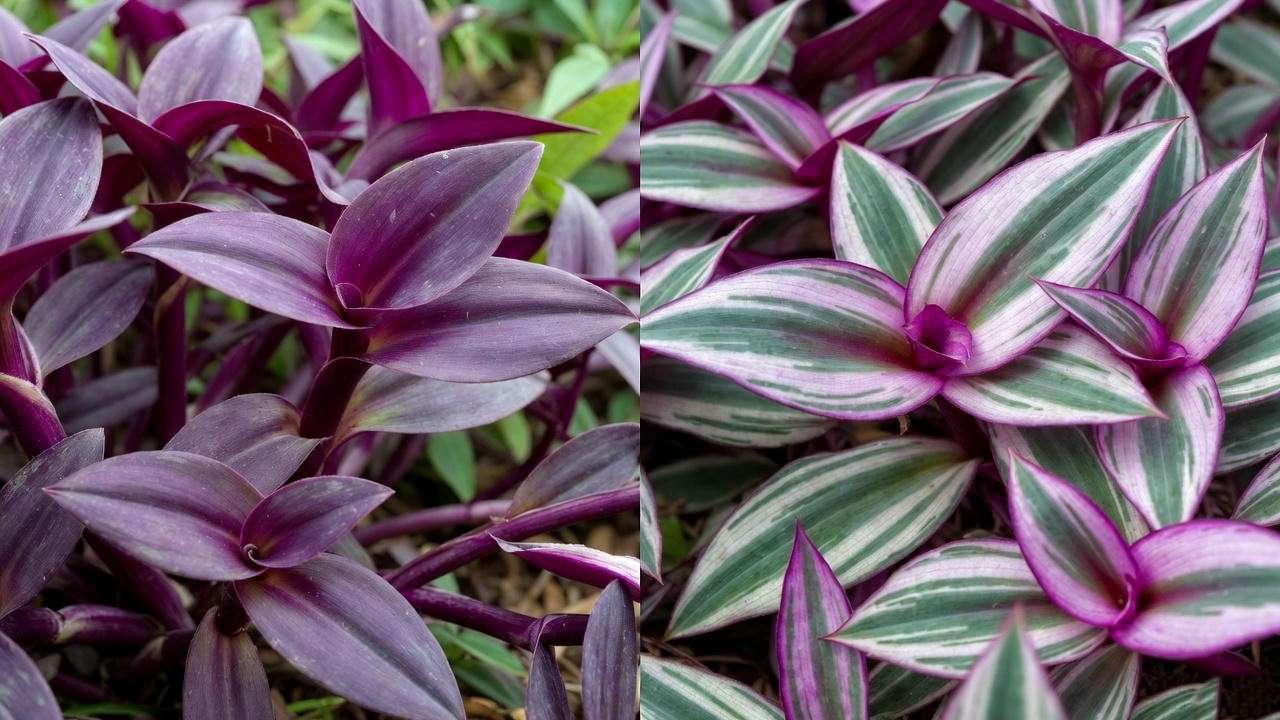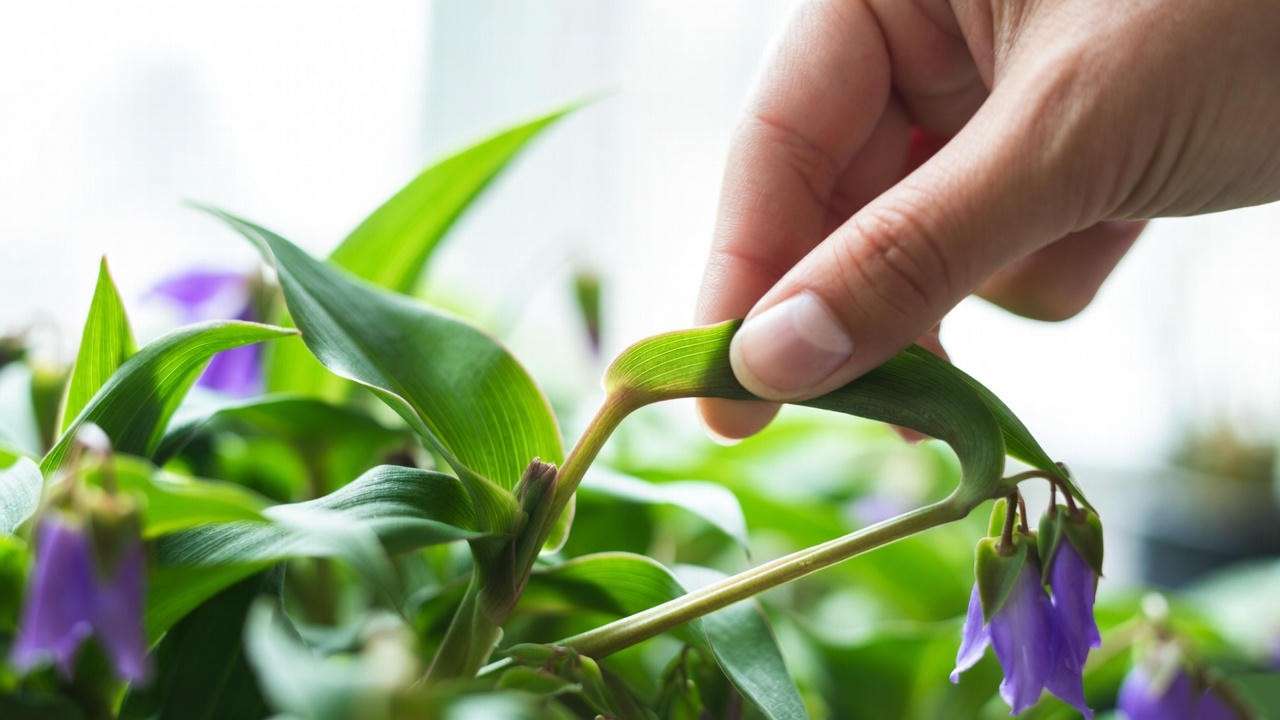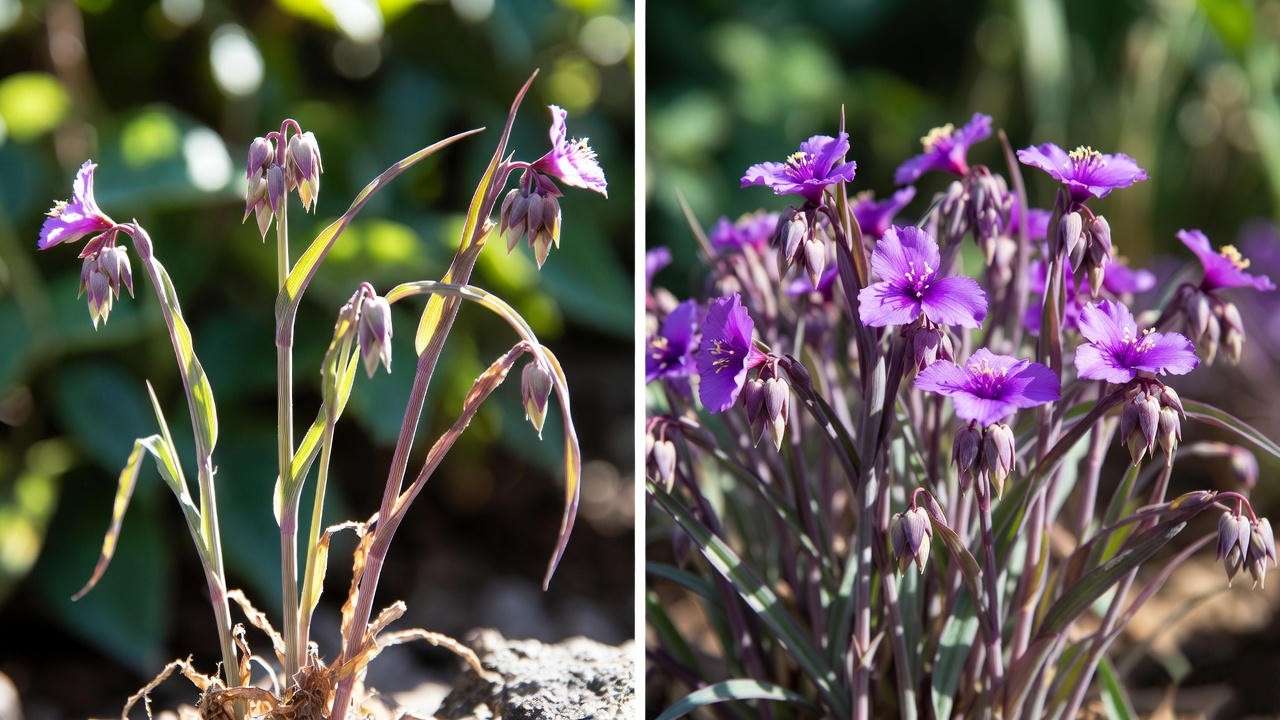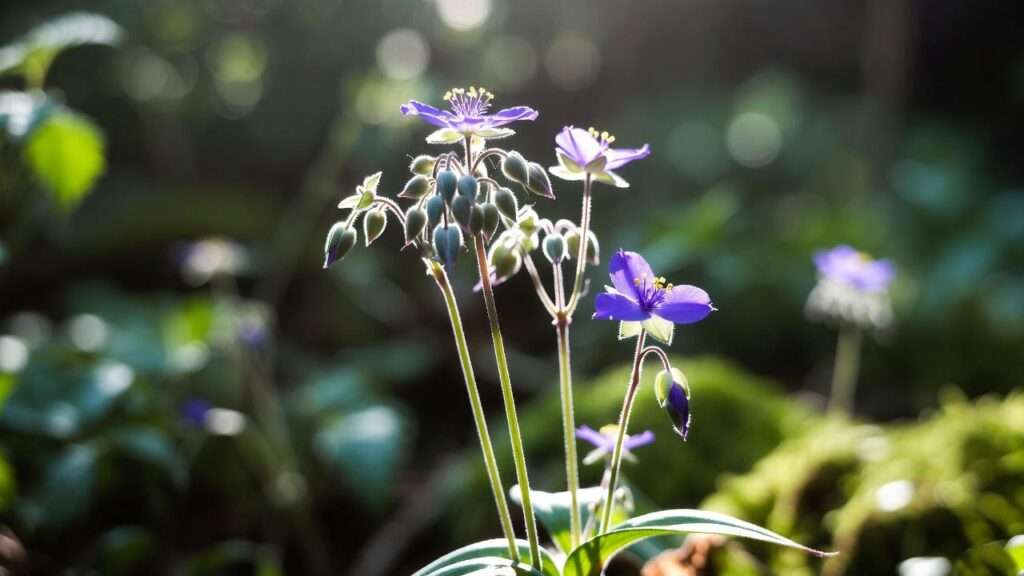Few plants offer the vibrant, no-holds-barred color and easy growth of the Purple Spiderwort Plant. With its signature trailing stems and velvety, deep-violet foliage, this stunning specimen instantly transforms any bright corner into a dramatic focal point. Whether you know it as $Tradescantia$ $pallida$ ‘Purple Heart,’ $Tradescantia$ $zebrina$ (often called the Inch Plant or Wandering Jew), or simply the classic Spiderwort, its appeal is undeniable.
However, the secret to a truly spectacular $Tradescantia$ isn’t just letting it grow—it’s understanding the precise conditions that unlock its deepest purple hue and prevent that dreaded “leggy” look. If you’ve struggled with pale leaves, sparse growth, or mushy stems, you’re in the right place.
As plant care experts, we’ve compiled this ultimate, comprehensive guide to help you cultivate a lush, thriving, and densely purple masterpiece. We’ll delve into the science behind its color, master its watering needs, and teach you the pruning techniques essential for bushiness. Get ready to stop merely keeping your purple spiderwort plant alive and start making it flourish.
II. Identifying Your Purple Spiderwort Variety 🔍
The term “Purple Spiderwort” is often used interchangeably for a few different, yet related, species within the $Tradescantia$ genus. While their care is largely similar, recognizing your specific variety is crucial for optimizing its light exposure—the single biggest factor in maximizing that rich purple pigment.

A. Why Identification Matters for Care
The depth of purple in these plants is due to anthocyanins, pigments produced by the plant in response to high light intensity. If you treat a variety that needs blazing sun like one that prefers dappled shade, you’ll end up with faded, greenish foliage.
B. $Tradescantia$ $pallida$ (‘Purple Heart’)
This is perhaps the most iconic of the purple spiderworts.
- Key Characteristics: Features thick, almost succulent stems and small, three-petaled pink flowers. The foliage is a uniform, deep, almost black-purple color.
- Light Requirement: This variety is the most light-hungry. It demands the brightest light possible—often direct morning sun or very strong filtered light—to maintain its deep, saturated color. In low light, it quickly reverts to a dull green.
C. Purple $Tradescantia$ $zebrina$ Cultivars
Also known as the Wandering Dude or Inch Plant, these plants are often confused with $T. pallida$, but their appearance and light tolerance differ.
- Key Characteristics: Defined by highly variegated leaves with stripes of purple, silver, and green. The leaves are generally thinner and the trailing habit is more pronounced.
- Light Requirement: Thrives in bright, indirect light. While it needs strong light to keep the purple banding vibrant, too much harsh, direct, midday sun can scorch the delicate leaves.
D. Other Purple Spiderworts (Brief Mention)
It’s worth noting the native $Tradescantia$ species (like $T. virginiana$), which are herbaceous perennials often grown outdoors in garden beds. They are cold-hardy and feature purple flowers rather than purple foliage, differentiating their care significantly from the tropical indoor varieties discussed here.
III. The Core Four: Essential Care Requirements 💧💡🪴🌡️
Mastering these four environmental factors is the foundation of successful $Tradescantia$ cultivation. Ignore any of them, and you risk a decline in color, health, and bushiness.
A. Lighting Requirements for Deep Purple Color
The Rule of Purple: For any purple $Tradescantia$ variety, the intensity of the light directly dictates the intensity of the color.
- Optimal Indoors: Place your plant in a location that receives bright, indirect light. An east-facing window is ideal as it provides gentle morning sun. A south or west-facing window works, but the plant must be set back a few feet or shielded by a sheer curtain to prevent scorching during the hottest part of the day. If your plant is stretching or turning green, move it closer to the light source.
- Optimal Outdoors: $Tradescantia$ $pallida$ can handle partial to full sun. For outdoor hanging baskets, aim for a spot that gets several hours of direct morning sun but is protected from the brutal mid-afternoon heat. This ensures maximum pigment production without leaf burn.
- Artificial Light Solution: If natural light is lacking, a strong, full-spectrum LED grow light placed 12-18 inches above the plant is an excellent solution for preventing etiolation (stretching).

B. Watering & Humidity Mastery
Overwatering is the number one killer of the $Tradescantia$ genus. They prefer consistent moisture but cannot tolerate soggy soil.
- The “Moist but Not Soggy” Method: Allow the top 1 to 2 inches of soil to dry out completely before watering again. When you do water, do so thoroughly until water runs freely from the drainage holes. Discard any standing water in the saucer after 15 minutes.
- Expert Tip: Signs of Trouble
- Overwatering: The classic sign is mushy, yellowing leaves and stems near the soil line, indicating root rot. This requires immediate action (see Troubleshooting).
- Underwatering: Leaves will become crispy, curled, and brittle, and the vibrant color may dull. This is easily fixed with a deep soak.
- Humidity: While not critically demanding, $Tradescantia$ appreciates average to high humidity (40% to 60%). Indoor forced-air heating can dry them out. Use a pebble tray with water beneath the pot or group plants together to create a localized microclimate. Misting is a temporary fix but is generally not as effective as other methods.
C. Soil and Potting Secrets
Your soil choice determines how efficiently water drains and how well the roots breathe.
- Best Soil Mix: Use a lightweight, fast-draining potting mix. A great recipe is two parts standard indoor potting soil mixed with one part perlite, pumice, or coarse sand. This aeration is key to preventing waterlogged conditions that lead to root problems.
- Drainage is Non-Negotiable: Never plant your spiderwort in a pot without drainage holes. If you use a decorative cachepot, ensure the inner growing pot can be easily removed for watering.
D. Temperature and Seasonal Care
Being tropical plants, they do not tolerate cold well.
- Temperature Range: Maintain consistent indoor temperatures between $65^{\circ}\text{F}$ and $75^{\circ}\text{F}$ ($18^{\circ}\text{C}$ and $24^{\circ}\text{C}$).
- Cold Sensitivity: Protect the plant from temperatures below $50^{\circ}\text{F}$ ($10^{\circ}\text{C}$), as cold drafts from windows or air conditioners can cause leaf drop and tissue damage.
- Winter Care: During the short, dark days of winter, $Tradescantia$ often enters a period of slower growth, or semi-dormancy. Reduce watering frequency (since evaporation is slower) and ensure the plant is getting adequate light, supplementing with a grow light if necessary. Avoid fertilizing completely during these months.
IV. Training & Maintenance for a Bushy Plant ✂️
One of the most common complaints about the purple spiderwort plant is that it becomes “leggy”—stems stretch out, leaves become sparse, and the plant loses its dense, vibrant look. This section details the expert techniques required to train your plant for maximum fullness and beauty.

A. Pruning to Prevent “Leggy” Growth (H3)
Pruning is not optional for $Tradescantia$; it is the most critical factor in maintaining a bushy, attractive shape.
- The Power of Pinching: To encourage lateral growth (side shoots), routinely pinch back the growing tips of the stems. Use clean scissors, snips, or your fingernails to remove the last half-inch of the vine, just above a leaf node. This seemingly small cut forces the plant to divert energy to dormant growth points, resulting in two new stems where there was only one, significantly increasing bushiness.
- Addressing Old or Sparse Growth: If a stem is very long and has dropped most of its lower leaves, pinching won’t be enough. This is where the “Chop-and-Prop” Rejuvenation Method comes in:
- Cut the sparse stem back to just 1 or 2 inches above the soil line.
- Take the long piece you cut off and propagate it (as detailed in Section V).
- Plant the new, rooted cuttings directly back into the mother plant’s pot. This cycle ensures the pot is constantly refilled with fresh, dense growth, completely eliminating legginess over time.
B. Fertilizing Schedule (H3)
While these plants are fast-growers, they are not heavy feeders. Over-fertilizing can lead to weak, scorched leaves.
- What to Use: A balanced, liquid houseplant fertilizer (e.g., NPK 10-10-10 or 20-20-20) diluted to half or quarter strength is perfect.
- When to Use It: Fertilize monthly during the active growing season (spring through early fall). Stop completely during the winter when growth slows.
C. Repotting (H3)
Purple spiderworts are vigorous, but they do not typically need annual repotting.
- When to Repot: Repot only when you notice signs the plant is pot-bound (roots circling the drainage holes) or when the soil quality has degraded (usually every 1 to 2 years).
- How to Repot: Move up only one pot size (e.g., from a 6-inch to an 8-inch pot). Repotting into a container that is too large can hold excess moisture, increasing the risk of root rot. Always use fresh, airy soil mix (see Section III.C).
V. Propagation: Creating New Purple Plants for Free 🎁
The $Tradescantia$ genus is incredibly easy to propagate—a trait that gives it the common name “Inch Plant” due to how quickly cuttings root. This ease of multiplication is your secret weapon for maintaining a full, dense, and vibrant plant collection.

A. The Stem Cutting Method (H3)
This is the most popular and successful method.
- Take the Cutting: Using clean shears, cut a 3 to 5-inch section of stem that includes at least two or three leaf nodes. Remove the leaves from the bottom node(s) as this is where the new roots will emerge.
- Water Propagation (Quick Visual Results): Place the cutting in a clear glass of water, ensuring the bare nodes are submerged. Place the glass in bright, indirect light. You should see roots developing within a week or two. Change the water weekly. Once roots are 1-2 inches long, transfer them to soil.
- Soil Propagation (For Robust Growth): Dip the cut end in rooting hormone (optional, but helpful) and plant it directly into a small pot filled with a well-draining soil mix. Keep the soil consistently moist (but not soggy) for the first few weeks until new top growth signals successful rooting.
B. Division Method
For very large, mature clumps, particularly the hardier outdoor varieties, you can divide the root ball during repotting. Gently tease the clump apart into smaller sections, ensuring each section has a healthy set of roots and stems, and replant the sections separately.
VI. Troubleshooting Common Purple Spiderwort Problems 🚨
Even with perfect care, these plants can present challenges. Knowing how to identify and quickly correct issues is the hallmark of an expert plant keeper.
A. Color Loss/Fading (H3)
- The Problem: Your beautiful purple foliage is turning pale, washed out, or even reverting to a dull green.
- The Solution: This is almost always a light deficiency. The plant is not receiving enough energy to produce the high level of anthocyanins needed for deep purple coloration.
- Action: Immediately move the plant to the brightest possible location. For $T. pallida$, this may mean putting it directly in front of a south or west-facing window, ensuring no obstructions.
- LSI Keyword: Ensure strong light intensity.
B. Leaves Turning Brown/Crispy (H3)
- The Problem: Leaf edges or tips are dry, brown, and brittle.
- The Solution: This is primarily an issue of under-watering or low humidity. If the plant sits near a heating or cooling vent, the dry air will pull moisture directly from the leaves.
- Action: Check your watering schedule; you may be waiting too long between soaks. Increase ambient humidity using a humidifier or by setting the pot on a pebble tray filled with water.

C. Yellowing/Mushy Stems (H3)
- 🚨 Critical Problem: Root Rot: Mushy, brown, or translucent stems and yellowing leaves that don’t crisp up are the classic signs of overwatering and root rot. The roots are literally suffocating and decaying in saturated soil.
- Action: Act fast. Unpot the plant immediately. Cut away all damaged, black, or mushy roots. If a large portion of the root ball is compromised, salvage the healthy stem tips and use the propagation method (Section V) to restart the plant in fresh soil. Do not reuse the old, contaminated soil.
D. Pest Control (H3)
$Tradescantia$ are generally pest-resistant, but they can occasionally attract indoor plant nuisances.
- Identify Common Pests: Look for signs of Spider Mites (fine webbing, tiny dots), Mealybugs (small, cottony white masses), or Aphids (small green/black clusters on new growth).
- Safe Treatments:
- For minor issues, spray the plant down thoroughly with a strong stream of water (especially the undersides of the leaves).
- Treat persistent pests with an application of neem oil solution or insecticidal soap. Always test the product on a small area first.
VII. Expert Insights & Creative Uses 🪴
Beyond basic survival, how can we truly maximize the visual impact and health of the purple spiderwort?
A. Indoor vs. Outdoor Considerations
- Tropical Varieties ($T. pallida$, $T. zebrina$): These thrive as houseplants year-round. They can be moved outdoors in summer but must be brought inside well before temperatures drop below $50^{\circ}\text{F}$.
- Hardy Varieties: Some $Tradescantia$ varieties are perennial and suitable for outdoor groundcover. If you are planting outside, ensure you are using a variety appropriate for your USDA hardiness zone. Be aware that the $T. zebrina$ and $T. pallida$ are extremely vigorous and can sometimes be classified as invasive in tropical and sub-tropical regions; always check local guidelines before outdoor planting.
B. Creative Display
The purple spiderwort’s graceful, trailing habit is its greatest asset.
- Hanging Baskets: Placing the plant in a hanging basket allows the purple cascades to be fully displayed.
- High Shelves: Position the pot on a high bookshelf or mantlepiece so the vines can spill down, adding vertical interest and color to your decor.
- “Spiller” in Containers: Use it as the “spiller” component in mixed outdoor patio containers, contrasting the rich purple against bright greens or yellows.
C. 💡 Expert Tip: Achieving Maximum Density
The ultimate secret to a constantly full, non-leggy purple spiderwort is routine pruning and repotting cuttings. Whenever you take a cutting, instead of starting a new pot, propagate it and plant it back into the top of the mother plant’s pot. This continual cycle of rejuvenation and infilling prevents the center of the pot from becoming sparse, guaranteeing a full, lush canopy year after year. This strategy is essential for long-term plant health and aesthetic appeal.
VIII. Conclusion: Your Thriving Purple Masterpiece 🏆
The purple spiderwort plant ($Tradescantia$) is truly one of the most rewarding and forgiving plants you can cultivate. By internalizing the core principles—providing abundant light intensity for rich color, practicing careful watering to avoid root rot, and maintaining a strict pinching and pruning schedule for bushiness—you possess all the expertise needed to transform a simple houseplant into a cascading, deep-purple masterpiece.
Stop fighting the legginess and fading color. Implement these techniques, and watch your $Tradescantia$ transition from surviving to spectacularly thrivi













